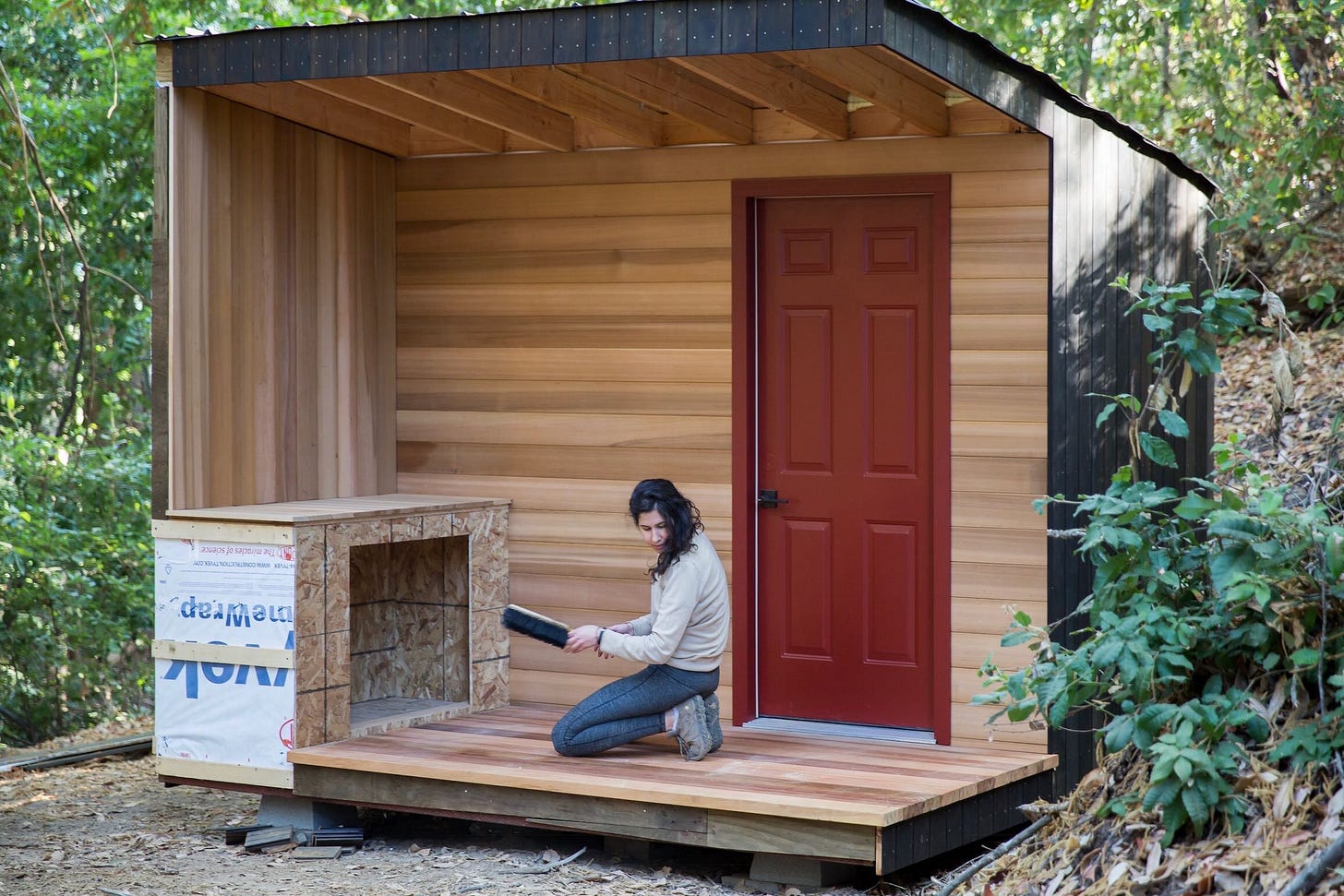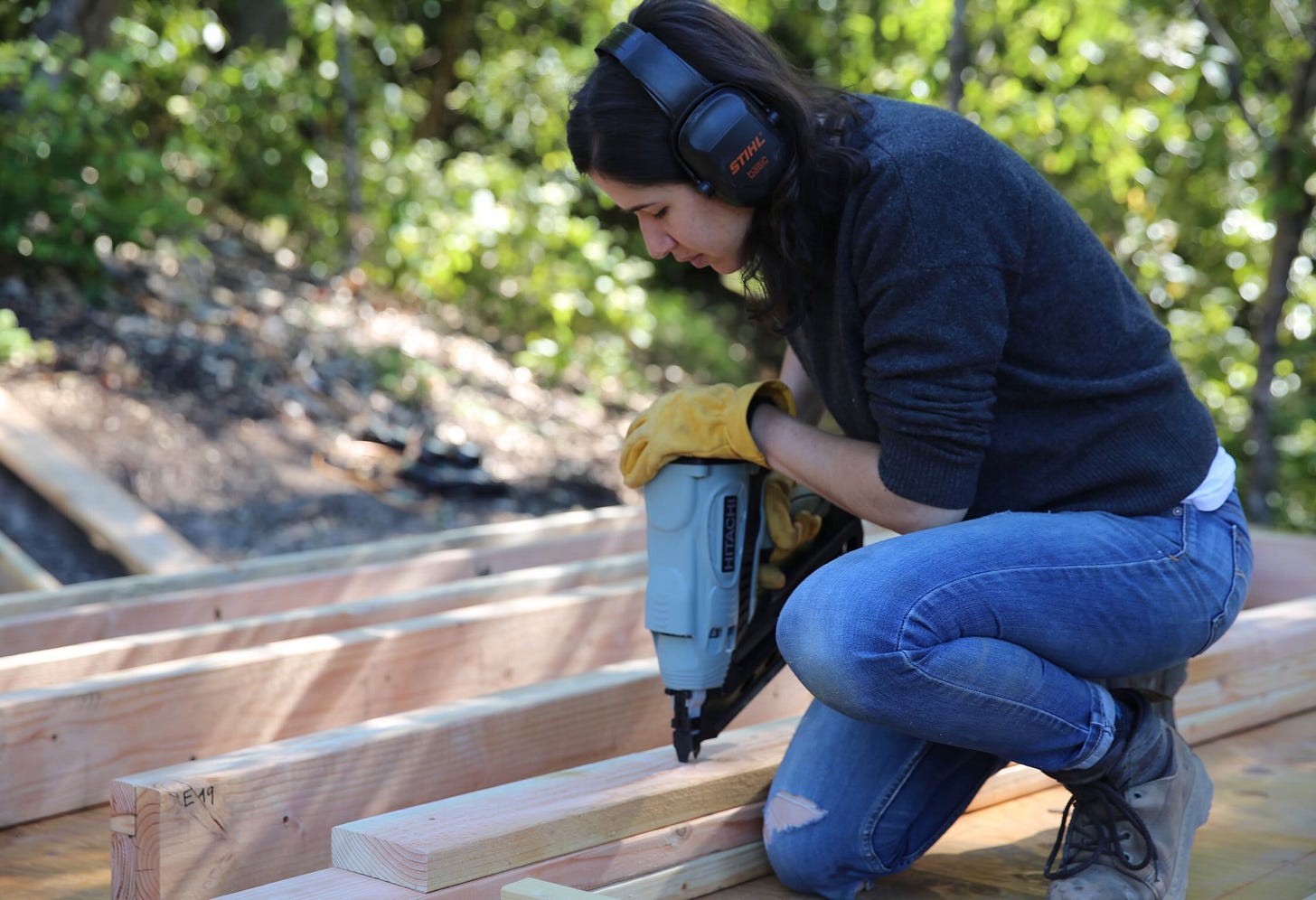How do I get started on my project?
Just start. On literally anything.
I’m frequently chatting with aspiring builders who are dreaming about taking the leap and constructing their own cabin. I get it. Cabins are romantic. They attract a lot of lofty goals.
Some will admit that the prospect is so enormous an undertaking that they’re paralyzed. Most won’t say that outright, but I know they’re probably biting off more than they can chew and will likely find it difficult to get the ball rolling on such a big project.
I usually try and talk these prospective builders out of larger cabin plans and advocate that they first build a tiny A-frame that requires a fraction of the time and money.
My advice to them: Learn some lessons. Start your cabin journey with a picnic table. Get some wins under your belt. Build confidence. Build a tiny structure. You’re more likely to see that cabin realized if you work your way up to it. Otherwise, it’s just an unapproachable fantasy.
Just as often, I hear from new builders who have more attainable goals, like basic furniture or a shed, yet they, too, are still (understandably) stuck. They see pictures of polished builds and a laundry list of supplies to order and it seems so much more than they can envision from themselves.
My advice to these folks—and really anyone: Just get started. Build something. Anything. Learn by doing, accept that you’ll make some mistakes, and just get going down that road — one foot in front of the other. Make a basic version of a daybed with plywood and screws and then, maybe, graduate to an improved version with better wood and hidden joinery.
How We Started Small
Case in point: We didn’t know what the hell we were doing when we bought our property. All we had was the fantasy—plus a cordless drill and a hammer, more or less.
Our first picnic table was built from some Internet plans. We worked our way up from bench, to table, to deck, to pavilion, to open-air shed. When we finally made the jump to a closed-in building, it was an outhouse. Lower stakes on a bathroom than a cabin, but we also were intentional about treating it like a real building and as a trial run for an eventual cabin build.
Only after 10 construction projects on that property did we finally pull the trigger on our cabin build. Baby steps.
Prototype Your Life
I was on a walk with Kevin Kelly last month. In his latest book, he dances around this topic a few times, advising you “prototype your life” and learn via baby steps. Or, put another way, the time for a project is now. So we were chatting about that.
He said, “I prototype anything I can with hot glue and cardboard. When we did a kitchen remodel, I prototyped the counters and island at full scale in large sheets of used cardboard from an appliance store. Made so many important changes based on that.”
That’s good advice to troubleshoot your design process, but it’s also just a great way to get over that hurdle of breaking ground on a full-scale project. Start with cardboard and hot glue and let go of the expectation of what follows. Just make a thing and see where it goes.
Beyond Building
We live in The Sunset neighborhood of San Francisco and frequently pass the former location of Trouble Coffee. Every time I think back to a This American Life episode which interviewed the owner, Giulietta Carrell, and the advice she was given that got her coffee shop (and its other locations) started.
[Host] John Gravois: Giulietta got the idea for Trouble in 2005. But it wasn't so much an idea as a whirlwind of coconuts and strangers meeting each other and cinnamon toast, all swirling around in her mind. She was working in a coffee shop at the time, always button-holing customers and coworkers about her plans.
She did the same with Glen, who brought the idea down to earth, telling her point blank to open a checking account, go to City Hall, and ask them about starting a small business. And her boss at the coffee shop found her sleeping there once or twice, and rather than say you're fired, he said, I think it's time for you to open your own place.
Giulietta Carrelli: Then he told me, he was like, just get some cups, brew some coffee. When you run out of cups, close the door and go get more cups.
[Host] John Gravois: [LAUGHS]
Guilietta Carrelli: And that was my business advice.
Don’t Kill Anyone
Now, I get that with construction a liiiittle more prudence is warranted. An elevated deck has a bit more liability than a cup of coffee. Fair enough. Peep some span tables to be sure you're mostly on the right side of the danger divide.
But here’s the thing: if you’re reading this and finding it relatable, you’re probably a ways off from any of those imagined problems and liabilities.
These theoretical problems are like those of the person who’s worried about lifting weights at the gym because they “don’t want to get too bulky.” Friend, that’s not a real concern. You’re not going to accidentally get stacked. It would require years of dedication (not unlike this hypothetical cabin build) and there’s going to be a lot of learning in between. Don’t tell yourself a story and get prematurely put off by the daunting hypothetical.
Point Being
Start small. Build stuff that won’t kill people. Do a little research, sure, but don’t burden yourself with the expectation of perfection or the assumption that it all has to be learned ahead of time.
If you actually do start down the road of doing, one foot in front of the other, I promise you’ll inevitably find your way deeper down the rabbit hole as you begin to put the puzzle pieces together, learn how to ask the right questions, and build up the confidence to dream bigger.
Doesn’t matter if it’s hitting the gym, picking up hobbies, selling coffee, or lofty cabin goals. We all start somewhere. Don’t stress the end game so much so that you never start.








